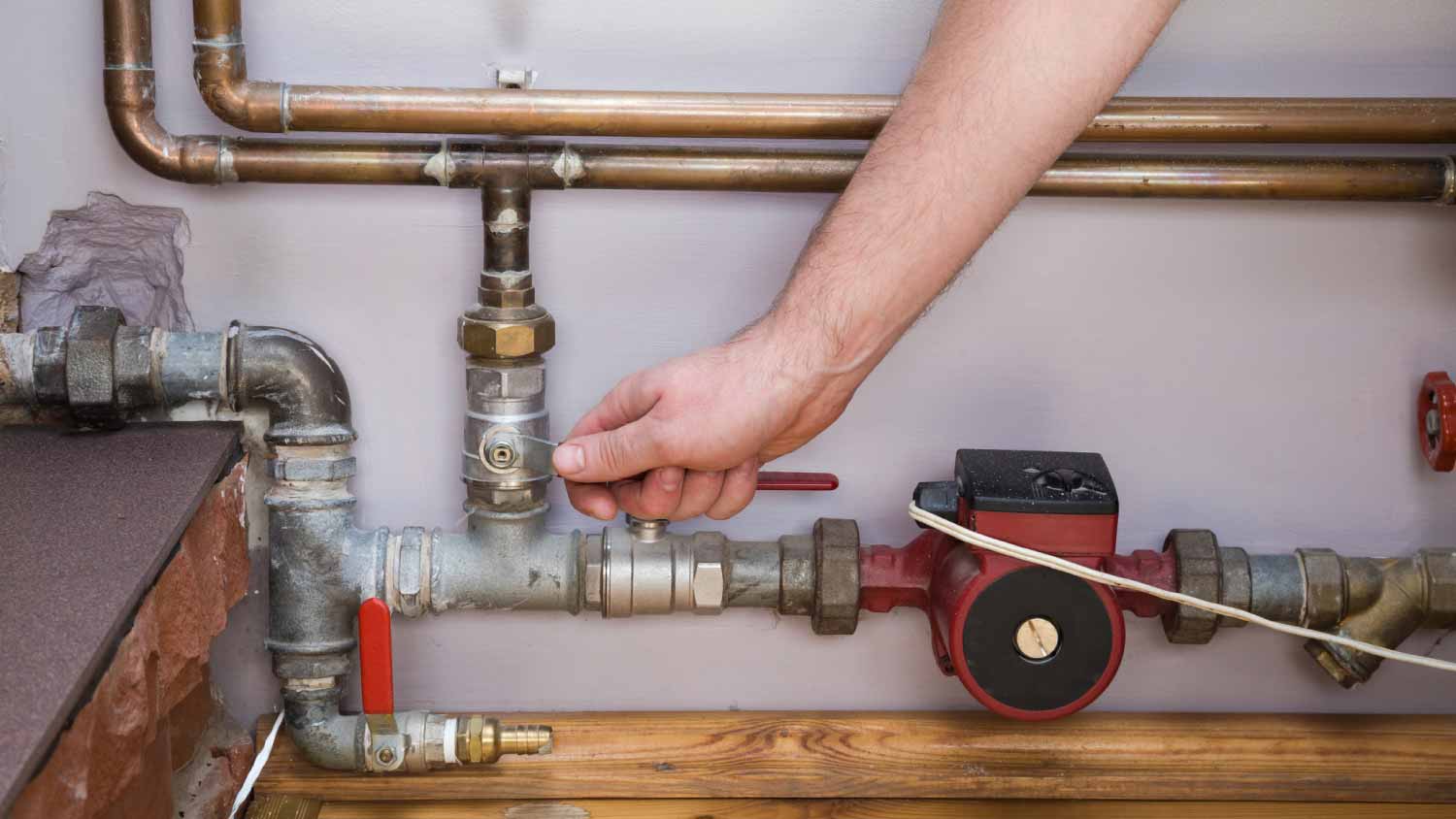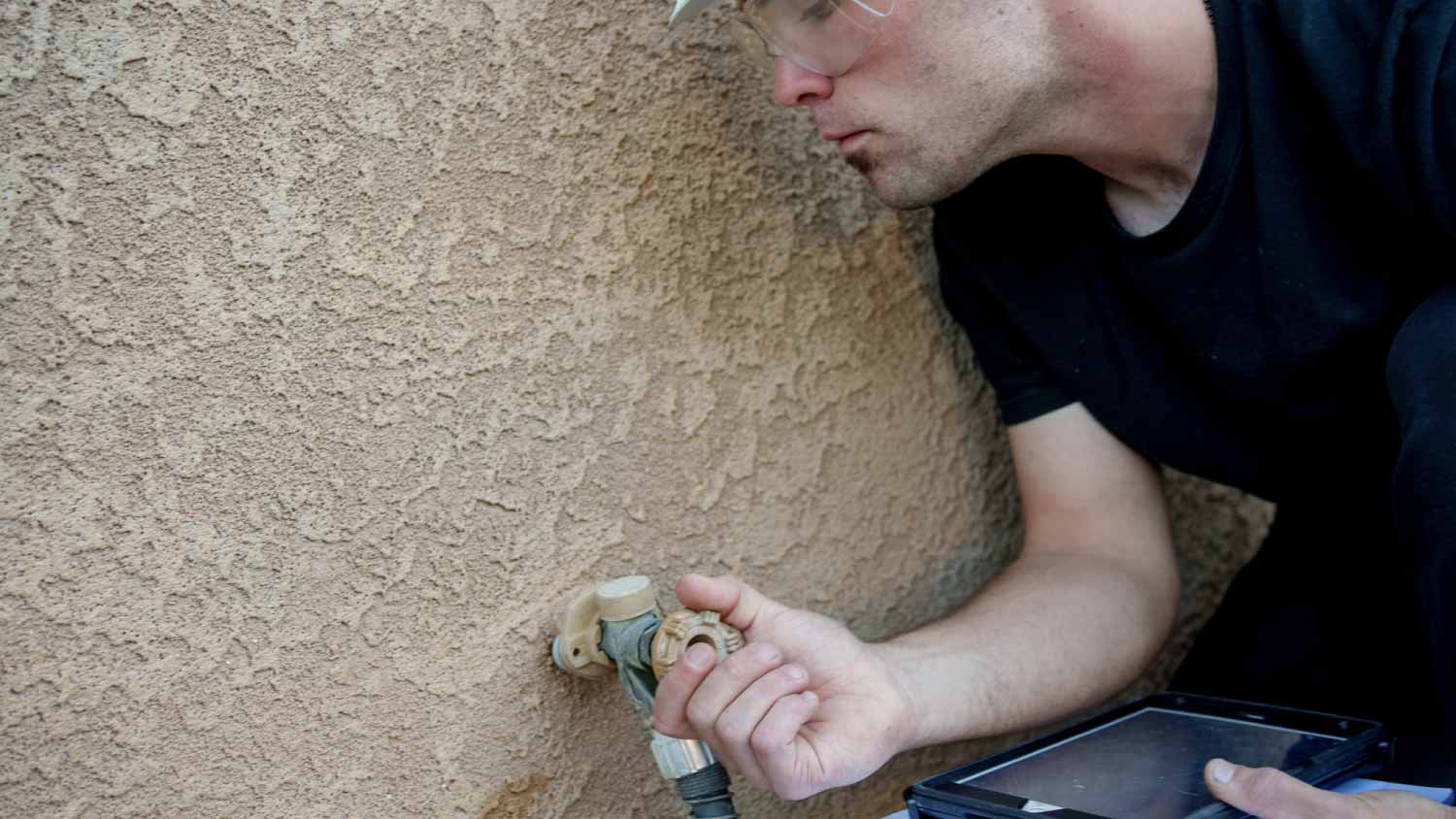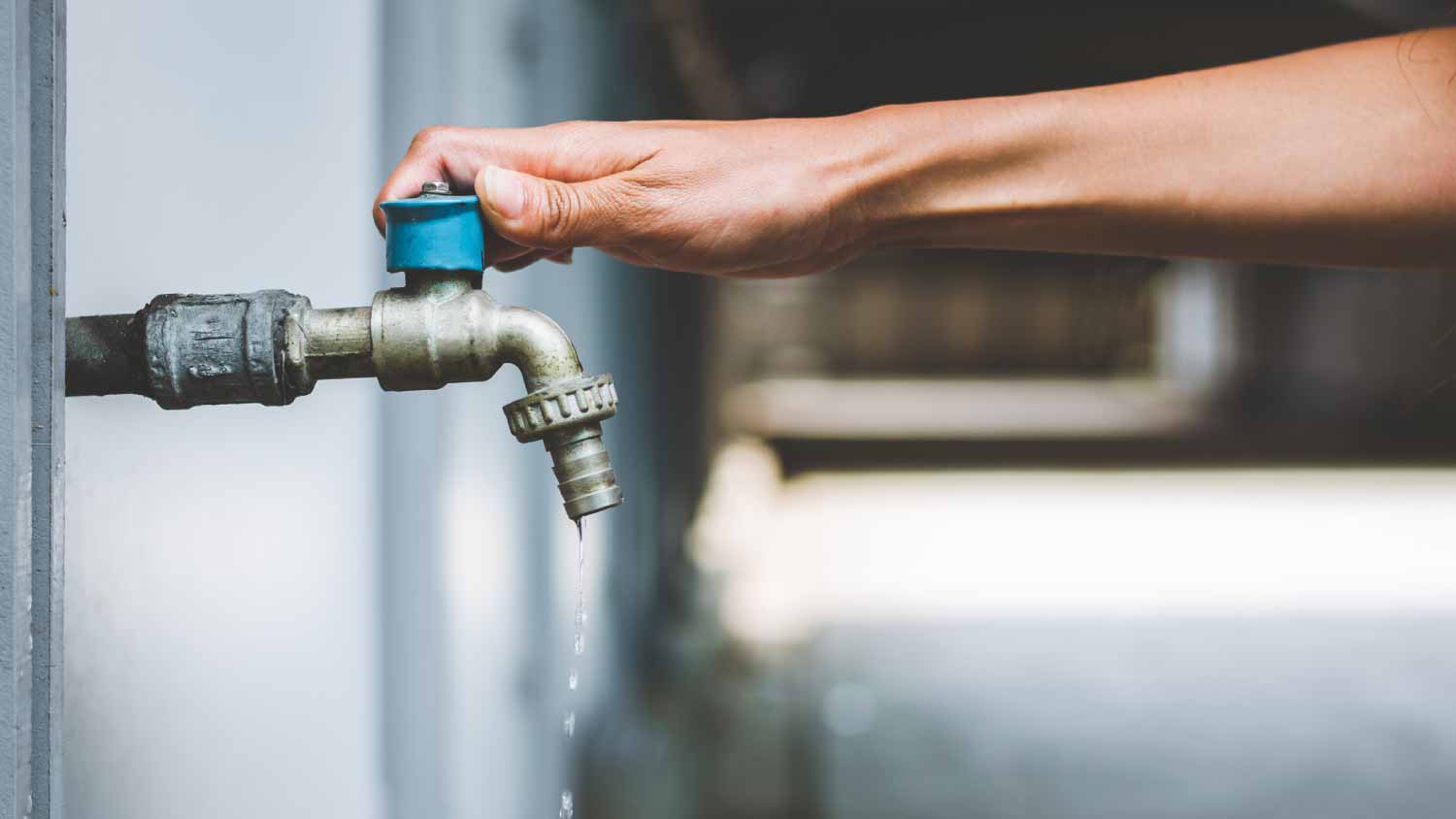How to Fix an Outdoor Faucet That Won’t Turn Off
Avoid turning your yard into a water park


It’s a pleasant summer weekend and you’re spending it leisurely washing your car. But when you finish, you try to shut the spigot off, and it won’t stop gushing water, no matter how hard you turn the handle. Your first instinct is to panic in this situation, but we’re here to calm you down and help you find a quick solution. Let’s discuss what to do when your outdoor faucet won’t turn off.
Why Won’t My Outdoor Faucet Turn Off?
The good news is that when your outdoor faucet won’t turn off, it’s usually a mechanical problem rather than a plumbing problem. Parts wear out over time, so you probably have a worn-out washer or anti-siphon valve that has stopped working. This makes it impossible for your faucet to differentiate if it's in the on or off position.
Numerous cracked, leaky pipes and other plumbing issues can also be culprits, but faucets that keep running can be fixed with simple tools and replacement parts.
How to Fix an Outdoor Faucet That Won’t Turn Off
1. Cut Off the Water Supply

Stopping water from coming down that faucet is your utmost priority. Leave the faucet in an open position rather than attempting to close it.
Open the faucet all the way and immediately head to your shut-off valve. If you’re unsure how to find your water shut-off valve, it’s located outdoors in most modern homes. You’ll likely find it somewhere along the perimeter of the house where it's accessible by street level. Turn this valve clockwise immediately so that water stops flowing to the outdoor faucet.
The shut-off valve could also be inside a utility box alongside your municipal valve. If it is, contact your local water department if the valves aren’t labeled. A neighbor might be able to help you determine which valve is the correct one as well. Knowing which valve is which is important because there may be legal consequences if you turn the municipal valve and accidentally take out your neighbors’ water as a result. If you’re panicked about a flooding yard, you might turn the wrong one in a frantic effort to make the flow stop.
If your home is older, the shut-off valve is likely to be indoors. Check your basement, utility closet, or crawlspace. The valve controlling the outdoor spigot should be labeled, and that's the one you want to close so that the rest of your plumbing is unaffected. Older valves that don't have handles might require some solid pliers or a wrench to turn.
With older homes, however, you may need to shut the water off for your entire home. Bear in mind that you won't be able to have a bubble bath or grab a glass of water until after this ordeal is in the rearview mirror. But doing this will prevent costly, devastating water damage to your yard and your house.
2. Drain Water From the Faucet
Once you've closed the valve and gotten water to stop gushing out of the spigot, drain the remaining water from the outdoor faucet. This aims to reduce the risk of a pipe bursting later. Enough water poured out to fill a couple of aquariums by now, causing water to get trapped in the faucet and pipeworks. If you don't drain the faucet now, it can compound a simple mechanical problem of the present into an expensive problem in the future.
Find the safety valve on your faucet. Pull the handle or turn the knob so that the trapped water drains.
3. Remove the Packing Nut Behind the Faucet Handle
With the water cut off and drained from the faucet, it's safe to disassemble your outdoor faucet so that you can inspect it more thoroughly. Get an adjustable wrench so that you can remove the packing nut that’s inside the valve assembly behind the spigot handle.
Turn the wrench counterclockwise to loosen the valve assembly. You might need a clamp or another wrench for the faucet connection so that it doesn't jostle while you do this. With the faucet firmly held in place by the clamp or extra wrench, take the entire valve assembly out with your hands.
Remove the faucet handle fastener with the adjustable wrench, wiggle the handle upwards to remove it, then unscrew the packing nut and remove it by sliding it up the stem.
If the valve assembly or packing nut stubbornly stays in the same place, spritz some WD-40 or penetrative oil on these parts and give it a few minutes. That should loosen up the valve assembly and packing nut, so you'll be able to remove them with the wrench.
Look Over the Packing Nut
Does the packing nut look like it's seen better days? Is it too tight or loose enough to fly right off? If so, the packing nut could be what’s causing the faucet to create a lake in your backyard. If not, it might be another part that needs replacement or a more serious problem like a leak.
4. Remove the Valve Stem
Use the pliers to hold the pipe steady, then flick the washer out from the valve stem with the flathead screwdriver.
Look at the washer and O-ring. If they look corroded or damaged, these were the parts that were causing the deluge.
5. Replace the Broken Parts as Needed

Make a note of the parts that are clearly broken or worn out. Snap a picture with your phone or bring them with you to a local hardware store to get replacements.
Once you've sourced the correct replacement parts, it's time to reassemble your faucet:
Replacing a Packing Nut
Put the new packing nut over the valve assembly, turning it clockwise with the adjustable wrench to tighten it. Be careful not to turn it too tight so that this problem doesn't happen again.
Replacing a Washer (Plus Screw)
Take the corroded washer off of the valve stem. Put some plumber's grease on the new washer before placing it on the valve stem. With the O-ring in place, replace the old screw that was on the washer with a new one.
Replacing an O-ring
Follow the exact same steps as replacing a washer to replace the O-ring. This means replacing the washer, screw, and O-ring for a total of three new parts.
6. Reassemble the Faucet
After the broken or corroded parts have been replaced, it's time to close the faucet and put the valve assembly back where it belongs. Pop it back into the faucet and tighten it with a wrench. Try not to tighten it too much so that the seal doesn't break.
7. Turn the Water Back On and Test

Confirm that the faucet is in closed position and go back to your outdoor shut-off valve or water supply valve to turn the water back on. Head to the outdoor faucet and turn the faucet on and off, testing if the water is flowing properly.
If the water is still uncontrollably flowing, or you’ve done the inverse and now it won’t turn on at all, call a plumber for help.
How to Prepare for Future Faucet Emergencies
Fortunately, an out-of-control outdoor faucet isn’t a regular occurrence. But in order to prepare for it in advance, these tips are a good rule of thumb so you know what to do if this emergency strikes.
Learn where your outdoor shut-off valve is located.
Keep spare washers and other parts on hand in a place where you can easily find them.
Keep bottled water on hand, enough for each household member plus pets for about two weeks. Have backup dishes and filtering solutions if your pet’s water needs are complex, like many exotic pets.
Make a list of nearby bathrooms and showers: friends, family, neighbors, 24-hour stores, gyms, any place that can meet your basic hygiene needs until the water comes back on.
Get to know your home insurance policy regarding water emergencies, and what they will and won’t pay for so you aren’t unexpectedly saddled with another massive bill on top of the repairs.
DIY vs. Hiring a Pro
If you know where your water shut-off valve is, you may not need a local plumber to fix this problem, depending on whether the issue is mechanical or a leak. Shut the water off first, then figure out if there’s a leak or other plumbing issue before you hire a pro.
Hiring a licensed plumber costs $150 to $600 to replace an outdoor faucet. However, this can also carry emergency fees of $100 to $150 if they need to come immediately. If it turns out to only be a mechanical problem after their inspection, you may still have to pay a service call fee of $100 to $250.
Frequently Asked Questions
There are few things more annoying than trying to fall asleep only to be woken up by the sound of a dripping faucet. If the faucet drips when the water is off, it probably has a loose or damaged seat washer. The screw gets loose from repeated use, making the faucet drip. With outdoor faucets, this is more common in the summer when people are using it more often to water the garden or cool off. Disassembling the faucet and tightening or replacing the seat washer and screw can get the dripping to stop.
If you had to shut your water supply off completely to fix your outdoor faucet problem, you need to take some precautions once it's restored. Stagnant water builds up in your plumbing lines and could contain lead, copper, and other sediments, meaning it isn't safe to drink, cook, or bathe yet. Spend about 30 minutes cleaning the pipes by running each faucet on cold. It also helps to run the shower and flush the toilets two or three times. This should get all the stagnant water out and make it potable again.
Shut-off valves, like any other piece of metal hardware, can corrode, age, get worn down, and eventually break or rust into place. Occasionally spray your shut-off valve with WD-40 to stall it from rusting. If it really gets stuck, a wrench and WD-40 will usually do the trick, but you will need to call a plumber if it’s completely unmovable.





- Gas Plumbers
- Plumbing Repairs
- Sump Pump Installation
- Wood & Pellet Stove Repair
- Shower Repair
- Wood Stove Services
- Emergency Plumbers
- Fire Sprinkler Contractors
- Perc Test Companies
- Toilet Repair & Installation
- Boiler Repair
- Sewer Line Repair
- Faucet Repair
- Main Drain Camera Companies
- Foundation Drain Installation
- French Drains
- Bathtub Replacement
- Subcontractors
- Storm Drain Contractors
- Affordable Plumbing
- Plumbing & Heating Companies
- Bathroom Repair Services
- Sink Installation
- Commercial Plumber
- Barndominium Builders
- Water Line Repair
- Faucet Installation
- Water Line Installation
- Leak Detection
- 5 Reasons Your Outdoor Faucet Makes Noise When Turned On and How to Fix It
- Here’s Why Water Is Dripping From Your Faucet—And How to Fix It
- Get To Know the Parts of a Sink Faucet
- How to Know if You Should Repair or Replace Your Leaky Faucet
- How to Replace Your Kitchen Faucet: A Complete DIY Guide
- 9 Potential Reasons Cold Water Isn’t Coming out of Your Faucet
- How Long Do Bathroom Faucets Last?
- How to Protect Outdoor Faucets From Freezing Temperatures
- 4 Common Problems With Touchless Faucets and How to Fix Them
- How to Replace a Spigot Valve to Ensure It's Frost-Proof










